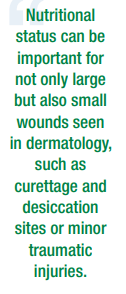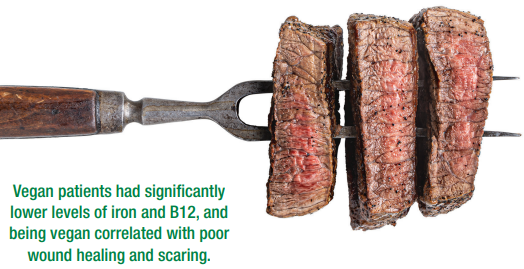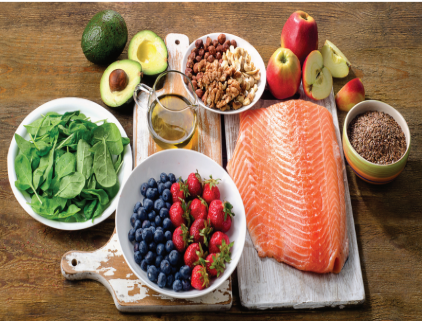Nutrition and Wound Healing
With Bridget Shields, MD

Dr. Bridget Shields discusses recognizing and addressing malnutrition in patients to improve the wound healing process.
“Subclinical ‘covert’ malnutrition is unbelievably common, even in elderly patients or patients who follow vegan or vegetarian diets. Many of the patients we see in dermatology suffer from chronic medical conditions, such as diabetes, inflammatory bowel disease, and even malignancies. And these can lead to even more drastic malnutrition,” said Bridget Shields, MD, Assistant Professor, Department of Dermatology, University of Wisconsin-Madison.
“In these populations, it’s especially important for dermatologists to recognize nutrition as a potentially modifiable risk factor in wound healing and recommend or provide appropriate assistance in recommending nutrient supplementation.”
Nutritional status can be important for not only large but also small wounds seen in dermatology, such as curettage and desiccation sites or minor traumatic injuries, said Dr. Shields who recently published “Diet in Wound Care: Can Nutrition Impact Healing” in Cutis.1
“Existing evidence supports adequate protein intake in wound healing, as well as vitamin C supplementation up to around 500 mg daily. I’ll also point out that arginine, an amino acid involved in the promotion of collagen synthesis through the stimulation of fibroblasts, as well as collagen deposition in wound beds, has been found to increase angiogenesis and things like scar remodeling.”
Dr. Shields sometimes will recommend arginine-rich foods, such as pumpkin seeds, soybeans, chickpeas, lentils, to patients undergoing wound healing after dermatologic procedures.
“But I do not currently recommend oral supplementation of arginine.”
Dr. Shields cites a recent observational study that compared postsurgical scars from nonmelanoma skin cancer excisions between vegan and omnivore patients.2 Outcomes included mean serum iron levels, vitamin B12 levels, wound diastasis, scar spread, and scar atrophy. Vegan patients had significantly lower levels of iron and B12, and being vegan correlated with poor wound healing and scaring.
“Ultimately, I think we need more data before we routinely recommend supplementation to healthy patients after skin surgery, but I do think encouraging a nutritious and well-balanced diet with adequate protein and arginine does make some sense,” she said.
The Physical Exam
Dermatologists manage a variety of wounds of different etiologies. And for all patients, Dr. Shields takes a thorough history and conducts a detailed review of systems. She also assesses skin ulceration, patients’ medical comorbidities, and medications.
“During my physical exam of the patient, I play close attention to skin hyper- or hypopigmentation. I play close attention to the hair, nails, lips, and tongue, as these can all be clues that can suggest an underlying nutritional deficiency.”
“I pursue a more detailed laboratory evaluation in patients with chronic wounds or risk factors that may predispose them to malnutrition. Specifically, [those risk factors are] wounds that are larger than a few centimeters in diameter and those with extensive exudate, as these have both been associated with increased risk for protein loss that may require supplementation. In the patients where I do pursue additional or more aggressive laboratory testing for nutritional deficiency, I focus on iron studies, zinc levels, and micronutrient assessments,” Dr. Shields said.
Supplementation and the Skin
Dr. Shields highlights the difference between supplementation for nutrient deficiency and prophylactic supplementation when nutrient levels are normal.

“I am extremely cautious with the latter and believe healthy patients can derive the majority of the nutrients they need to heal wounds from a well-balanced diet. In patients who do need supplementation, I use an evidence-based approach to dosing and duration of therapy because overly aggressive supplementation portends its own risks.”
For example, hypervitaminosis can result in hepatic damage, excessive bleeding, itching, dermatitis, and hair loss. Zinc supplementation can interfere with the absorption of other micro-and macronutrients—things like copper and iron.
“A lot of patients ask me about herbal supplementation for wound healing, using products like spirulina, echinacea, or alfalfa. Unfortunately, many of these supplements have immunostimulatory effects that can be dangerous for patients with underlying autoimmune diseases.”3

The Dermatologist’s Role
Wound healing is multifactorial, and dermatologists have to consider the whole patient in their approach and treatment of skin ulcers, said Dr. Shields.
“In my chronic wound patients, I try to address the other factors that can also impact wound healing. I discuss glucose control with my diabetic ulcer patients; compression stockings and leg elevation with my stasis ulcer patients; and offloading and movement in my pressure ulcer patients.”
“In terms of optimizing nutrition for wound care, I think it is the responsibility of the dermatologist to at least discuss diet and nutrient supplementation with our patients. And these conversations should be tailored to the individual patient,” she said.
In relatively healthy individuals without risk factors for malnutrition, it may be enough to recommend adequate protein intake and a well-balanced diet with lots of fruits and vegetables. But in sick patients with multiple medical comorbidities and nonhealing wounds, a consultation with a dietician may be necessary, said Dr. Shields.
“Dermatologists can start by expanding their awareness of the conditions that predispose to malnutrition, by recognizing malnutrition early (with those physical exam findings), by assessing nutritional status in at-risk patients and by using evidence-based guidance to supplement accordingly.”
According to Dr. Shields, more focused research is needed. But studies focused on dietary interventions and nutrient supplementation can be challenging to perform. Many of the existing studies are confounded by multi-nutrient supplementation, using a variety of brands and doses.
“I think simplifying our evaluations and studies to individual nutrients, and then performing that quality randomized controlled trial will provide the best evidence for dermatologists moving forward,” Dr. Shields said.
By Lisette Hilton
________________________________________________________________________________________________________
References:
- Shields BE. Diet in Wound Care: Can Nutrition Impact Healing? Cutis. 2021 December;108(6):325-328. doi:10.12788/cutis.0407.
- Fusano M, Fusano I, Galimberti MG, Bencini M, Bencini PL. Comparison of Postsurgical Scars Between Vegan and Omnivore Patients. Dermatol Surg. 2020;46(12):1572-1576. doi:10.1097/DSS.0000000000002553
- Ravishankar A, Bax CE, Grinnell M, et al. Frequency of immunostimulatory herbal supplement use among patients with autoimmune skin disease [published online ahead of print, 2022 Jan 6]. J Am Acad Dermatol. 2022;S0190-9622(22)00012-3. doi:10.1016/j.jaad.2021.12.050

